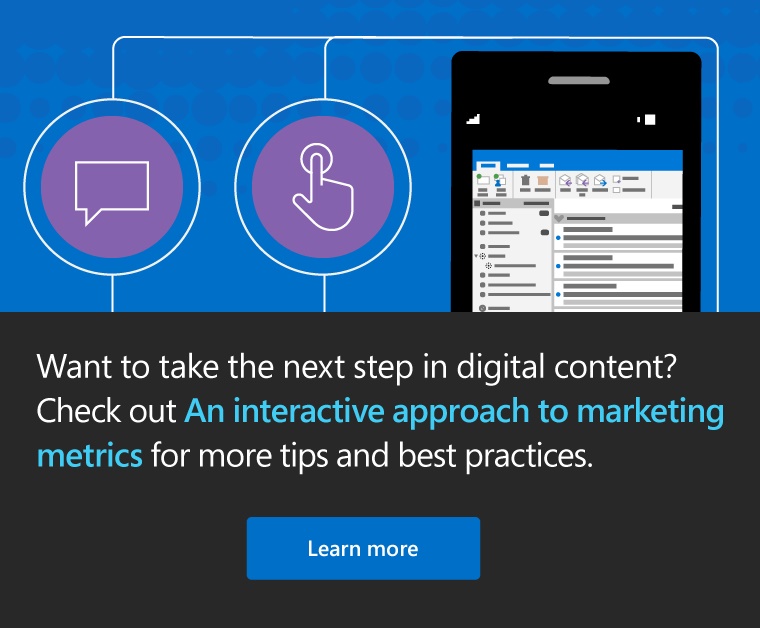
The dynamics of an interactive experience
We’re all bound to the capabilities of our available platforms. While these limitations are often negligible at first—Facebook’s analytics work well enough for aspiring content campaigns, for example. But over time, many content creators find that the resources at hand don’t quite fit your overall vision, and as a result your creative ambition gets boxed in by the very tools we’ve come to rely on.
Interactive content breaks down those barriers by equipping creators with a new world of possibility. With the right research, investment, and understanding, interactive content marketers can create their ideal deliverables, such as an immersive multimedia site, a refined online experience, or a more sophisticated analytics engine. But, like any campaign, interactive content hinges on understanding the strategy behind it.
Static vs Dynamic contentStatic content—blogs, images, videos—are limited by their nature. You post your blog, someone clicks a link, and if you’re lucky, they read it, learn something, and maybe share it with a friend. You can track things like returning visits, page time, and bounce rate with static content, but ultimately those assets operate on a one-way communication track: they’re telling your customers something about your brand. Interactive expands that relationship by creating a more dynamic exchange between you and your audience. You can record how a customer interacts with a site, analyze quiz answers, or trade knowledge for personal information and use that new data to curate a more intuitive customer experience.
Interactive in actionAt Microsoft, we’re promoting a Dynamics 365 webinar series for organizations that want to explore how new tools like Artificial Intelligence and the Internet of Things can help them better prepare for the future. These webinars span from entry level digital transformation conversations to specialized field service connectivity methods, but they all share a similar point of entry: a gated landing page. In exchange for access to our thought leaders’ insights, we ask each viewer for some basic information (name, email, phone number, and location). With this, we can do a few things:
- At a basic level, trading our expertise for the viewer’s contact information helps us build qualified leads for Dynamics 365. We can look at their decision to watch the webinar and know that, to some extent, they have a need that we can help resolve.
- We can document which webinars users sign up for, and which ones they don’t, to better identify the existing needs and trends in the current business market, and adapt our overall marketing strategy accordingly.
- By logging which specific webinars the user registers for, we can better assess their personal pain points and interests and provide them with more personalized content. If the user signs up for sales webinars, but skips the field services videos, then we know to focus more on offering them sales-centric content in the future.
By taking an interactive approach to our webinar series, we are able to produce content that’s more valuable to our viewers, and better shape our products and promotions based on the data we’re collecting. It’s the dynamic capabilities of interactive content that allows us to refine the user experience, and ultimately produce more engaging products and tools for our customers.
The value of personalizationInteractive content’s ability to help curate user-based content goes beyond informing strategic decisions, it helps your brand connect to the audience on a personal level. According to HubSpot’s 2017 Demand Generation Benchmarks Report, brands worldwide generate an average of 1,877 leads every month, at just under $200 per lead.1 That’s $375,400 per month spent finding customers that might be interested in your offerings. Personalization helps improve the ROI on that investment by showing customers that you’re listening and that you care about their needs. You can monitor customer data to better determine their needs and interests and provide more intuitive customer service. In fact, personalized emails have shown to help improve click-through rates by 14% and conversation by 10%2, while in-house marketers that create personalized web experiences see a 19% increase in sales3. The attention that comes with interactive content reminds your audience that they’re not just a sale, they’re a person, and that care fosters greater engagement and brand loyalty and differentiates your brand from other competitors.
Creating interactive content gives your brand the opportunity to adapt and evolve your campaigns based on input taken directly from your audience. As you create your own interactive strategy, consider what problems you hope to solve—are you looking for higher website return rates, improved bounce rates, more conversions? Set realistic goals for those key performance indicators, and monitor your performance. Then, as your content starts to take off, adapt it accordingly. Interactive content provides you with the tools to not only collect, but manage that data in real time and tweak what isn’t working and emphasize what is to create a more inviting and intuitive customer experience. To learn more about the basics of interactive content and the many forms it takes, be sure to check out the next post in the series, How interactive experiences bring your content to life and keep an eye on Microsoft in Marketing for more great tips for transforming your content campaigns into dynamic experiences.
1 https://offers.hubspot.com/2017-demand-generation-benchmarks-report
2 http://www.aberdeen.com/research/4904/ra-email-marketing/content.aspx
3 https://www.monetate.com/blog/the-tipping-point-for-personalized-website-experiences/?p=2013/05/the-tipping-point-for-personalized-website-experiences/





